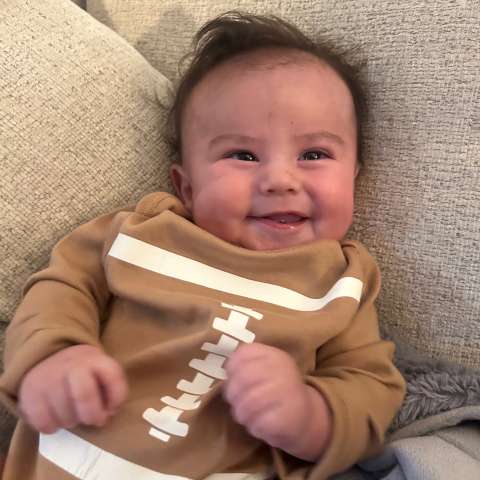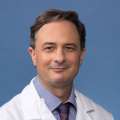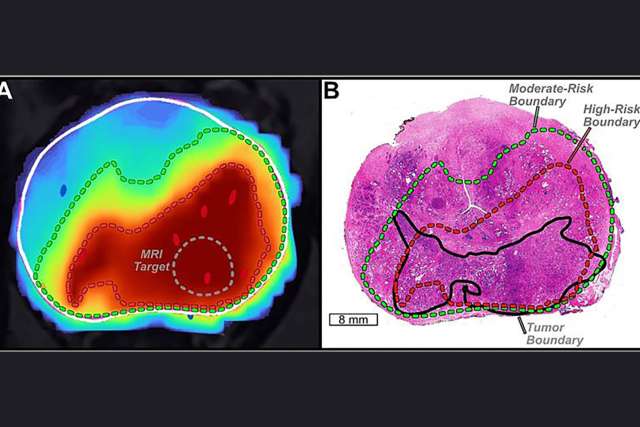During Nicolette Cortez’s pregnancy with her son, Aiden, there were no signs anything was amiss.
Even after Aiden’s birth on March 24, 2025, his only diagnosed issue was a mild case of jaundice. The condition, common in newborns, is characterized by a mild yellow tinge to the eyes and skin, caused by elevated bilirubin levels as the liver becomes fully functional.
It wasn’t until a follow-up pediatric visit when Aiden was 5 days old – and a chance emergency room visit at Children’s Hospital of Orange County (CHOC) immediately afterward – that life-threatening issues emerged, leading to a three-month hospitalization and two open-heart surgeries.
“It was almost 5 pm when we got a call from his pediatrician,” Cortez said. The results of Aiden’s bloodwork during the visit with the doctor were inconclusive, and the doctor wanted to have his levels checked again prior to Monday so he could begin photo light therapy quickly if needed. (Phototherapy is commonly used on newborns to supplement the work of their livers in reducing bilirubin levels if the situation doesn’t resolve on its own.)
Aiden’s parents called the two nearby labs the pediatrician recommended but found that they couldn’t do the tests over the weekend without an appointment. At that point, Aiden’s doctor instructed them to go to the emergency room at CHOC to get the bloodwork done.
Struggling to breathe
Aiden didn’t need phototherapy, but he had an additional worrisome symptom: difficulty breathing. Before releasing him, the ER doctors decided to run additional tests. An X-ray later that evening showed that Aiden had cardiomegaly (an enlarged heart), and he was admitted to the hospital for further evaluation.
The next morning, an echocardiogram provided more insight into why Aiden had been working so hard to breathe. He had an aortopulmonary window, a rare abnormal opening between the aorta and the pulmonary artery that accounts for less than half of one percent of all congenital heart defects.
“Developmentally, it’s thought that the two vessels develop from a single one,” said Ming Si, MD, a congenital cardiac surgeon and cardiovascular researcher at UCLA Health who also performs surgeries at CHOC, as part of the UCLA-CHOC Congenital Heart Program to provide pediatric congenital cardiac care.
The aorta is a high-pressure vessel, while the pulmonary artery is a low-pressure vessel, Dr. Si explained. When there’s an incomplete division between the two, “you have high-pressure blood going into the low-pressure system, meaning into the lungs.” The abnormal blood flow creates extra workload for the heart.
The situation isn’t always caught immediately in newborns, he explained. That’s because pulmonary artery pressure is initially high, effectively equalizing the pressure between the two vessels and limiting the errant blood flow. But, as the pulmonary artery pressure goes down, the blood flow increases, as do symptoms.
Initially, the hope was that surgery could be postponed for a couple of months. “They wanted him to be bigger and stronger,” Cortez recalled. “But he was having issues eating – he was getting really tired. And he had to go on high-flow oxygen because his oxygen levels were dropping.”
The surgery would have to take place immediately.
Aiden was placed on a ventilator, and a nasogastric tube was threaded through his nose into his stomach to provide nutrients. Then, on April 9, when he was barely 2 weeks old, he underwent open-heart surgery.
Dr. Si patched the opening in his pulmonary artery so it would no longer be receiving blood directly from the aorta.
Respiratory arrest, and the race to find out why
In the days following the surgery, however, Aiden continued to struggle. Four days later, he went into respiratory failure.
The CHOC team immediately placed Aiden on a heart-lung machine – an extracorporeal membrane oxygenation machine, known as ECMO – and reached out to Dr. Si.
The critical question: What caused the respiratory failure?
After a detailed evaluation of Aiden’s airway, the answer emerged. He had congenital tracheal stenosis, causing an abnormally narrow trachea (windpipe), along with a variation in its branching pattern.
Ordinarily, the rings of the trachea are made up of both cartilage and muscle. The cartilage forms a “C” shape, and the trachealis muscle bridges the gap to form a complete ring. In babies with congenital tracheal stenosis, however, the rings are smaller than normal and formed completely of cartilage, impeding the movement of air and breathing.
Dr. Si would need to operate on Aiden again, this time on the trachea, with an expanded team of specialists.
He arranged to have Aiden transferred via air ambulance to UCLA Mattel Children’s Hospital where Sohit Kanotra, MD, runs the UCLA Complex Pediatric Airway Reconstruction, Swallowing Disorders and Tracheostomy Program.
Once Aiden arrived at UCLA Health, Dr. Kanotra performed a bronchoscopy to obtain images of Aiden’s airway. Gregory Perens, MD, pediatric cardiologist, then created a 3-D-printed model of Aiden’s trachea for Drs. Si and Kanotra to plan the surgery.
“In complex airway reconstruction, precision and planning are everything,” Dr. Kanotra said. “At UCLA Health, we integrate advanced imaging, 3-D modeling, and surgical simulation before stepping into the operating room. That preparation allows us to perform complex surgeries safely on even the tiniest patients.”
On May 20, when Aiden was nearly 2 months old, Drs. Si and Kanotra performed a complex procedure known as a slide tracheoplasty to widen his airway. This entailed cutting the windpipe at the exact midpoint, then making lengthwise cuts in the two segments and suturing them together. Aiden’s newly constructed windpipe is now twice the diameter of the previous one, Dr. Kanotra said. To accommodate the anomalous branching pattern of Aiden’s trachea, the slide tracheoplasty had to be modified to occur in a side-to-side fashion.
The surgery involved close collaboration with UCLA’s cardiothoracic surgery team, reflecting the teamwork that defines the institution’s approach to complex pediatric cases. “We are truly grateful to have such a dedicated partnership with our cardiothoracic colleagues at UCLA,” Dr. Kanotra said.
In addition to Dr. Kanotra and Dr. Si, Aiden’s surgical team included Reshma Biniwale, MD, who is board-certified in congenital cardiac surgery.
As Aiden recovered, he remained heavily sedated and on a ventilator. About a week after the surgery, he was extubated and began the step-down process from receiving high-flow oxygen to regular oxygen and, finally, to breathing regular room air, Cortez recalled.

Even after he was breathing on his own, he still needed to be weaned off of the many pain medications he’d been on, but this needed to be done slowly so he wouldn’t experience withdrawal symptoms. Aiden was transferred back to CHOC to continue the medication-weaning process and to begin physical and occupational therapy.
“Because he’d been intubated for so long,” Cortez said, “he was having a really hard time taking a bottle.”
The whole time Aiden had been hospitalized, he’d been receiving nutrients via a nasogastric tube. Without the ability to take a bottle, Aiden would need to continue being tube-fed. After a procedure to switch him to a gastric tube (to eliminate the discomfort of having a tube in his nose), Aiden was finally allowed to go home, just in time for his 3-month birthday.
A ‘beautiful airway’
Aiden underwent a follow-up bronchoscopy in August. He has “a beautiful airway,” Dr. Kanotra said. He’ll have another bronchoscopy at the six-month mark and then will have them annually until age 5.

Dr. Kanotra attributes Aiden’s success to UCLA’s collaborative model of care, which brings together experts across multiple specialties — including pediatric otolaryngology, cardiac surgery, neonatology, critical care, and rehabilitation — all working with a single shared goal: the patient’s recovery.
“At UCLA, the patient truly is the center of every treatment decision,” Dr. Kanotra said. “Our collaborative environment – especially for the management of complex patients with airway and swallowing disorders – coupled with cutting-edge technology and expert intensivists and surgeons, allows us to provide state-of-the-art care for babies like Aiden.”
Aiden is currently receiving occupational and physical therapy, Cortez said. He’s a bit behind in meeting various developmental milestones, she noted, given that he was hospitalized for the first three months of his life.
But he’s now completely weaned off of the pain medications, allowing Cortez and her husband, Eddie Cortez, to see his true personality.
“He’s so much more energized now,” Cortez said.
Aiden recently underwent a swallow study (an imaging test for evaluating the mechanics of swallowing), given that it’s still difficult for him to take bottles. The results showed that he was aspirating liquids but did fine with purees, Cortez said.
He’ll continue to receive follow-up care, including for his swallowing issues, at the new Pediatric Airway and Swallowing Disorders Clinic at Ronald Reagan UCLA Medical Center.
Feeding issues are common in cases such as Aiden’s, Dr. Kanotra noted. “But with the new clinic, he’ll be able to see all of the specialists he needs under one umbrella.”
“Our goal is not just to repair airways, but to give children their breath, voice and ability to thrive,” Dr. Kanotra said. “The UCLA Complex Pediatric Airway and Swallowing Disorders Program brings together ENT, pulmonary, GI, speech-language pathology, and cardiothoracic teams under one roof. It’s one of the few programs nationally offering such comprehensive aerodigestive care.
“Aiden’s recovery reflects what’s possible when expertise, technology and compassion come together. That’s the heart of our mission at UCLA — to make world-class, multidisciplinary care accessible to every child who needs it.”
Related article
New UCLA clinic provides coordinated care for pediatric aerodigestive patients







